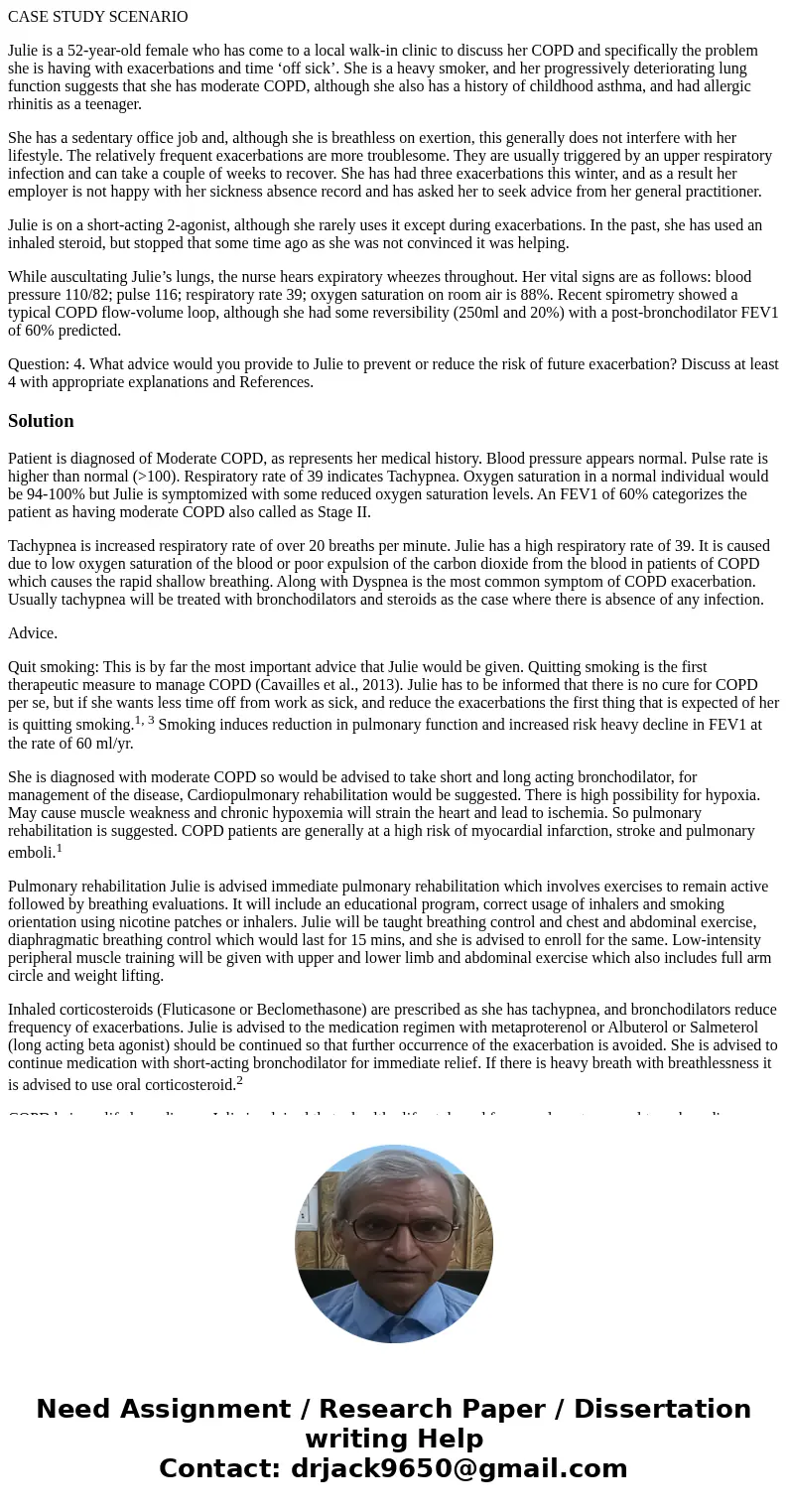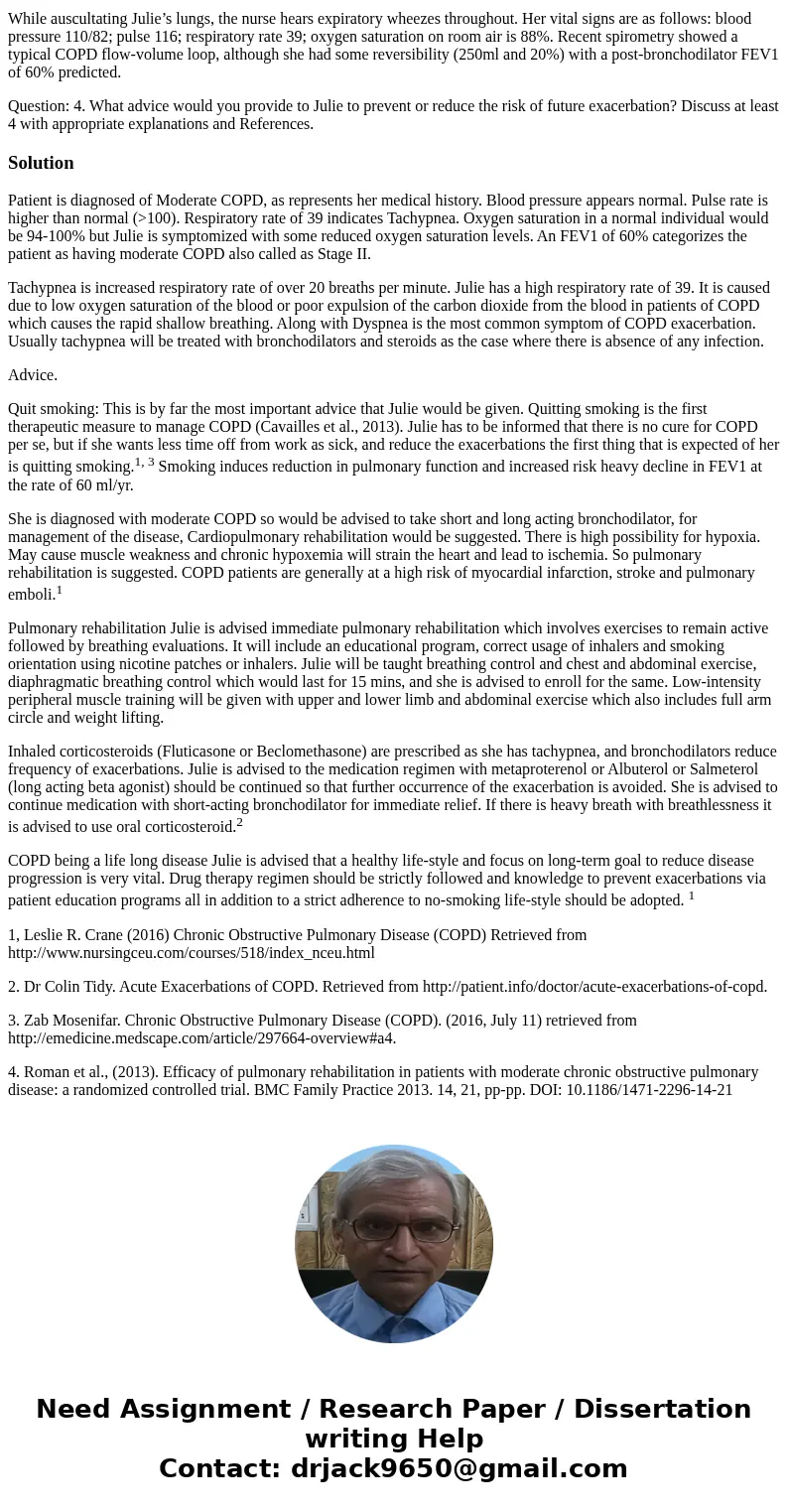CASE STUDY SCENARIO Julie is a 52yearold female who has come
CASE STUDY SCENARIO
Julie is a 52-year-old female who has come to a local walk-in clinic to discuss her COPD and specifically the problem she is having with exacerbations and time ‘off sick’. She is a heavy smoker, and her progressively deteriorating lung function suggests that she has moderate COPD, although she also has a history of childhood asthma, and had allergic rhinitis as a teenager.
She has a sedentary office job and, although she is breathless on exertion, this generally does not interfere with her lifestyle. The relatively frequent exacerbations are more troublesome. They are usually triggered by an upper respiratory infection and can take a couple of weeks to recover. She has had three exacerbations this winter, and as a result her employer is not happy with her sickness absence record and has asked her to seek advice from her general practitioner.
Julie is on a short-acting 2-agonist, although she rarely uses it except during exacerbations. In the past, she has used an inhaled steroid, but stopped that some time ago as she was not convinced it was helping.
While auscultating Julie’s lungs, the nurse hears expiratory wheezes throughout. Her vital signs are as follows: blood pressure 110/82; pulse 116; respiratory rate 39; oxygen saturation on room air is 88%. Recent spirometry showed a typical COPD flow-volume loop, although she had some reversibility (250ml and 20%) with a post-bronchodilator FEV1 of 60% predicted.
Question: 4. What advice would you provide to Julie to prevent or reduce the risk of future exacerbation? Discuss at least 4 with appropriate explanations and References.
Solution
Patient is diagnosed of Moderate COPD, as represents her medical history. Blood pressure appears normal. Pulse rate is higher than normal (>100). Respiratory rate of 39 indicates Tachypnea. Oxygen saturation in a normal individual would be 94-100% but Julie is symptomized with some reduced oxygen saturation levels. An FEV1 of 60% categorizes the patient as having moderate COPD also called as Stage II.
Tachypnea is increased respiratory rate of over 20 breaths per minute. Julie has a high respiratory rate of 39. It is caused due to low oxygen saturation of the blood or poor expulsion of the carbon dioxide from the blood in patients of COPD which causes the rapid shallow breathing. Along with Dyspnea is the most common symptom of COPD exacerbation. Usually tachypnea will be treated with bronchodilators and steroids as the case where there is absence of any infection.
Advice.
Quit smoking: This is by far the most important advice that Julie would be given. Quitting smoking is the first therapeutic measure to manage COPD (Cavailles et al., 2013). Julie has to be informed that there is no cure for COPD per se, but if she wants less time off from work as sick, and reduce the exacerbations the first thing that is expected of her is quitting smoking.1, 3 Smoking induces reduction in pulmonary function and increased risk heavy decline in FEV1 at the rate of 60 ml/yr.
She is diagnosed with moderate COPD so would be advised to take short and long acting bronchodilator, for management of the disease, Cardiopulmonary rehabilitation would be suggested. There is high possibility for hypoxia. May cause muscle weakness and chronic hypoxemia will strain the heart and lead to ischemia. So pulmonary rehabilitation is suggested. COPD patients are generally at a high risk of myocardial infarction, stroke and pulmonary emboli.1
Pulmonary rehabilitation Julie is advised immediate pulmonary rehabilitation which involves exercises to remain active followed by breathing evaluations. It will include an educational program, correct usage of inhalers and smoking orientation using nicotine patches or inhalers. Julie will be taught breathing control and chest and abdominal exercise, diaphragmatic breathing control which would last for 15 mins, and she is advised to enroll for the same. Low-intensity peripheral muscle training will be given with upper and lower limb and abdominal exercise which also includes full arm circle and weight lifting.
Inhaled corticosteroids (Fluticasone or Beclomethasone) are prescribed as she has tachypnea, and bronchodilators reduce frequency of exacerbations. Julie is advised to the medication regimen with metaproterenol or Albuterol or Salmeterol (long acting beta agonist) should be continued so that further occurrence of the exacerbation is avoided. She is advised to continue medication with short-acting bronchodilator for immediate relief. If there is heavy breath with breathlessness it is advised to use oral corticosteroid.2
COPD being a life long disease Julie is advised that a healthy life-style and focus on long-term goal to reduce disease progression is very vital. Drug therapy regimen should be strictly followed and knowledge to prevent exacerbations via patient education programs all in addition to a strict adherence to no-smoking life-style should be adopted. 1
1, Leslie R. Crane (2016) Chronic Obstructive Pulmonary Disease (COPD) Retrieved from http://www.nursingceu.com/courses/518/index_nceu.html
2. Dr Colin Tidy. Acute Exacerbations of COPD. Retrieved from http://patient.info/doctor/acute-exacerbations-of-copd.
3. Zab Mosenifar. Chronic Obstructive Pulmonary Disease (COPD). (2016, July 11) retrieved from http://emedicine.medscape.com/article/297664-overview#a4.
4. Roman et al., (2013). Efficacy of pulmonary rehabilitation in patients with moderate chronic obstructive pulmonary disease: a randomized controlled trial. BMC Family Practice 2013. 14, 21, pp-pp. DOI: 10.1186/1471-2296-14-21


 Homework Sourse
Homework Sourse